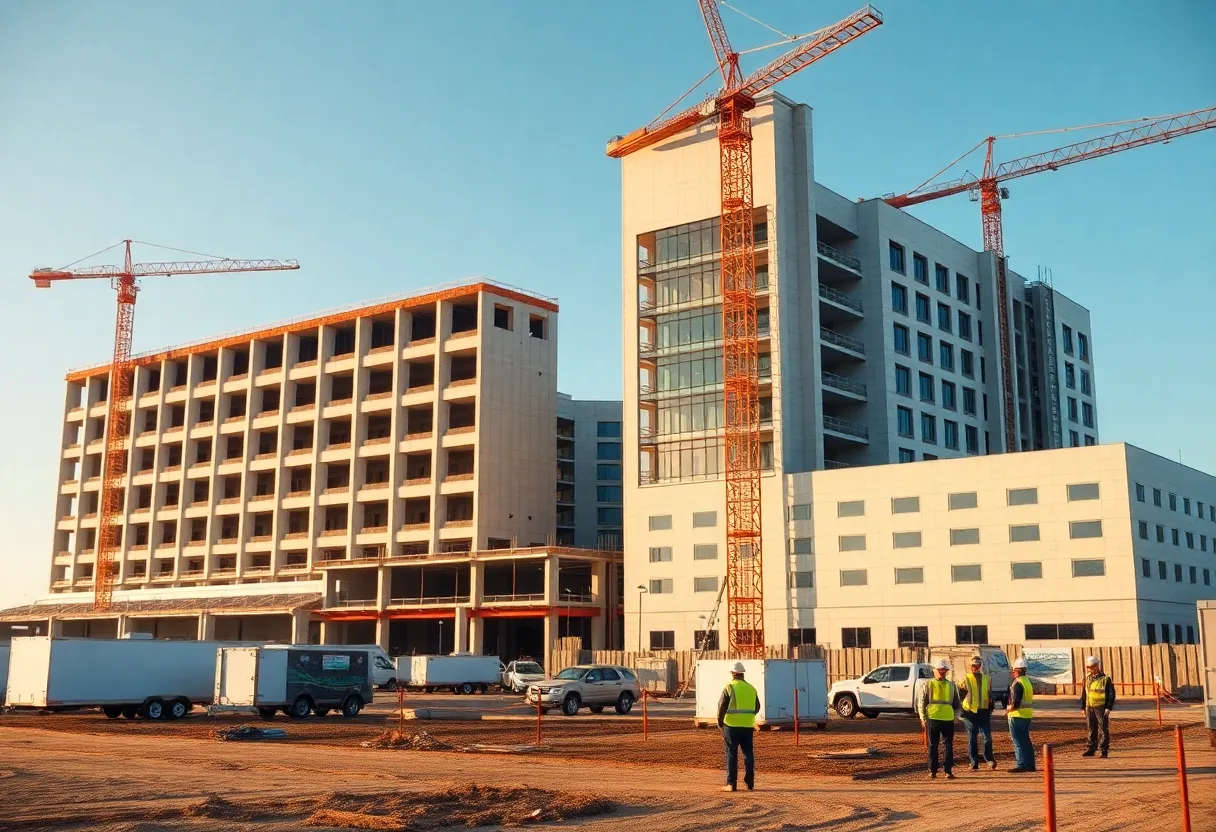Lee County, Florida, August 22, 2025
News Summary
Skanska has been awarded a roughly $435 million public-private partnership to deliver a 560,000-square-foot hospital and medical office complex in Florida. The project includes a five-story hospital and an adjacent medical office building, central energy plant, ambulatory surgery center and expanded emergency capacity. Skanska plans to use Integrated Project Delivery, design-assist, prefabrication and BIM to reduce cost and schedule, citing typical savings of 10–15%. The firm emphasizes local hiring and supplier development, with a majority of subcontracting expected to be local and a significant share awarded to minority firms. Utility work is already underway.
Skanska wins $435 million Lee Health hospital job as U.S. healthcare construction heats up
Lead
A major construction win in Florida underscores a wider boom in healthcare building. Sweden-headquartered Skanska has secured a $435 million public-private partnership to build a new hospital and medical office campus for Lee Health. The deal and Skanska’s use of Integrated Project Delivery (IPD) and other innovations point to faster timelines and lower costs as demand for health facilities climbs across the U.S. and the globe.
Key project details and timeline
The Lee Health project includes a roughly 416,000-square-foot, five-story hospital and a 125,000-square-foot medical office building with an ambulatory surgery center, together totaling about 560,000 square feet of care space. The new complex will contain up to 168 patient rooms, 10 operating rooms in each main building, and 44 emergency department beds. Work on utilities has already started, with the campus slated to open in the fourth quarter of 2027. The project will replace an older 414-bed hospital that will remain in operation through the buildout.
Why this matters now
The project is a visible example of why healthcare construction is a hot market. U.S. spending on healthcare construction reached about $69.78 billion by 2025, up roughly 2.1% year over year. Longer-term, the global healthcare construction market is forecast to grow from about $284.6 billion in 2024 to $442.0 billion by 2034, showing sustained expansion in the sector.
Drivers behind the surge
The market push is driven by several forces: an aging U.S. population with those aged 65 and over expected to grow by about 20% by 2030; the move toward more outpatient and ambulatory care, where ambulatory surgical centers (ASCs) are expanding fast at an estimated 12.3% CAGR; and post-pandemic modernization needs. Hospitals are also prioritizing seismic-resistant designs, energy-efficient systems, modular construction, and other resiliency features.
Skanska’s approach: IPD, prefabrication and local partnerships
Skanska has leaned on Integrated Project Delivery (IPD), design-assist methods, prefabrication and Building Information Modeling (BIM) to lower cost and speed schedules. The firm reports 10–15% savings in cost and time using these methods, with the Golisano Children’s Hospital project in Florida cited as an example where a co-located “Big Room” team cut costs by about 10% and accelerated the schedule by about 15%. Other examples include a hospital completed three months early and a tower expansion that used prefabrication and BIM to save about $3.5 million and 10 weeks.
Supply-chain, labor and cost headwinds
The sector still faces pain points. Material costs have risen, with steel and rebar prices reported up about 15% since 2019. Regulatory complexity and rising input costs have prompted delays and some cancellations in projects. Builders are responding with tighter partnerships, local subcontractor engagement, training programs, audits, and cross-training to keep schedules on track.
Local impact and diversity commitments
The Lee Health project is notable for its contractor choices: roughly 55% local subcontractor participation and about 22% minority subcontractor participation have been reported. The project includes a central energy plant, rehabilitation gym, specialty clinics and is intended to consolidate pediatric and other services into a single regional hub.
Market outlook and financial context
Analysts point to the U.S. market undergoing a structural shift in the next decade. One projection shows a U.S. healthcare construction CAGR of about 5.3% from 2023–2030. Design-build activity is strong too, with roughly $119 billion of projected spending under that model and a projected CAGR near 4.6% from 2024–2028. At the same time, the global opportunity—projected to reach $442.0 billion by 2034—is being cited as a long-term runway for builders that can win long-term contracts and deliver savings.
Skanska’s U.S. programs and pipeline
Skanska’s U.S. arm has long-running programs to grow local partners and diversify suppliers. A training program launched in 2007 has educated roughly 800 companies and led to about $740 million in work with Skanska. The firm’s pipeline includes micro-hospitals, specialized care centers and sustainability-focused hospital expansions, and it reports significant education and school work in some states as well.
What to watch next
Key items to track include the Lee Health project’s progress through construction and cost approvals, Skanska’s ability to win additional public-private partnerships in the coming year, and how builders handle rising materials costs and labor pressures. The project will be included in Skanska’s order bookings for the fourth quarter of 2024.
FAQ
What is the Lee Health project and who is building it?
The project is a new hospital campus for Lee Health including a five-story hospital and a medical office building with an ambulatory surgery center. Skanska is the contractor under a public-private partnership valued at roughly $435 million.
When will the new hospital open?
Utility work has begun and the complex is scheduled to open in the fourth quarter of 2027.
How much can construction methods like IPD save?
Integrated Project Delivery and related methods are reported to deliver about 10–15% savings in cost and time on projects that use co-located teams, prefabrication and BIM.
How big is the healthcare construction market?
U.S. healthcare construction spending was about $69.78 billion by 2025. The global market is projected to grow from about $284.6 billion in 2024 to $442.0 billion by 2034.
What are the main risks for healthcare construction?
Major risks include rising material costs (steel and rebar up roughly 15% since 2019), regulatory hurdles, labor shortages and supply-chain disruptions.
Key features at a glance
| Feature | Detail |
|---|---|
| Project value | $435 million |
| Project size | 560,000 square feet (hospital + medical office) |
| Key methods | IPD, design-assist, prefabrication, BIM |
| Reported savings | 10–15% in cost/time on IPD-enabled projects |
| Market outlook | Global market to $442.0 billion by 2034; U.S. sector growing at ~5.3% CAGR (2023–2030) |
| Local participation | 55% local, 22% minority subcontractor participation reported |
| Completion target | Q4 2027 |
Deeper Dive: News & Info About This Topic
Additional Resources
- Construction Dive: Skanska Florida hospital (Lee Health PPP)
- Wikipedia: Skanska
- CoStar: Skanska’s new South Florida vice president to spearhead growth
- Google Search: Skanska South Florida vice president
- Global Construction Review: Skanska completes $38M Florida high school expansion
- Google Scholar: Skanska Florida high school expansion
- Construction Dive: Skanska mentor small-business program
- Encyclopedia Britannica: Skanska small business program
- WEAR-TV: Court sides with Skanska, dismisses claims over Hurricane Sally damages
- Google News: Skanska Hurricane Sally court
Author: Construction CA News
The CALIFORNIA STAFF WRITER represents the experienced team at constructioncanews.com, your go-to source for actionable local news and information in California and beyond. Specializing in "news you can use," we cover essential topics like product reviews for personal and business needs, local business directories, politics, real estate trends, neighborhood insights, and state news affecting the area—with deep expertise drawn from years of dedicated reporting and strong community input, including local press releases and business updates. We deliver top reporting on high-value events such as the Rose Parade, Coachella, Comic-Con, and the California State Fair. Our coverage extends to key organizations like the California Building Industry Association and Associated General Contractors of California, plus leading businesses in technology and entertainment that power the local economy such as Apple and Alphabet. As part of the broader network, including constructionnynews.com, constructiontxnews.com, and constructionflnews.com, we provide comprehensive, credible insights into the dynamic landscape across multiple states.




